

Science Update: The Science Radio News Feature of the AAAS. April 18, 2013 Researchers are learning what surfaces geckos stick to best.
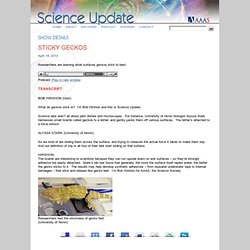
Podcast: Play in new window Transcript BOB HIRSHON (host): What do geckos stick to? Science labs aren’t all about petri dishes and microscopes. ALYSSA STARK (University of Akron): So we kind of are sliding them across the surface, and trying to measure the actual force it takes to make them slip. HIRSHON: The lizards are interesting to scientists because they can run upside down on wet surfaces – so they’re strongly adhesive but easily detached. Researchers test the stickiness of gecko feet. Science Update: The Science Radio News Feature of the AAAS. April 17, 2013 Olympic-level athletes have some enhanced cognitive abilities.
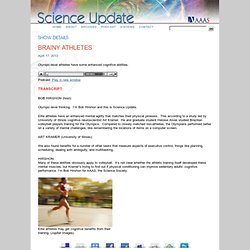
Podcast: Play in new window. Science Update: The Science Radio News Feature of the AAAS. April 16, 2013 Each carnivorous pitcher plant contains a unique food web, depending on what falls in.
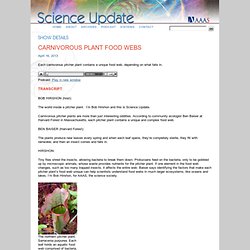
Podcast: Play in new window Transcript BOB HIRSHON (host): The world inside a pitcher plant. Carnivorous pitcher plants are more than just interesting oddities. Science Update: The Science Radio News Feature of the AAAS. April 15, 2013 Energy drinks and red meat contain carnitine, a substance that promotes heart disease with the help of gut bacteria.
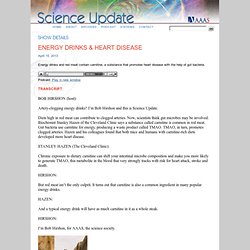
Podcast: Play in new window Transcript BOB HIRSHON (host): Science Update: The Science Radio News Feature of the AAAS. April 12, 2013 Despite its reputation, cholesterol may be useful for treating several medical conditions.
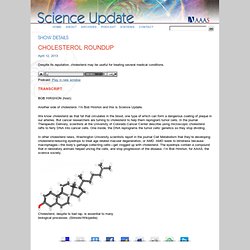
Podcast: Play in new window Transcript BOB HIRSHON (host): Another side of cholesterol. We know cholesterol as that fat that circulates in the blood, one type of which can form a dangerous coating of plaque in our arteries. Science Update: The Science Radio News Feature of the AAAS. April 11, 2013 New research suggests that young children understand the concept of fairness, but desire gets in the way of sharing.
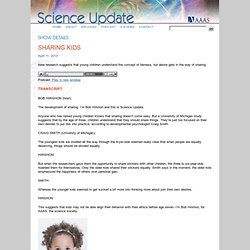
Podcast: Play in new window Transcript. Science Update: The Science Radio News Feature of the AAAS. April 10, 2013 Inspired by animals, researchers have created robots that can traverse sand.
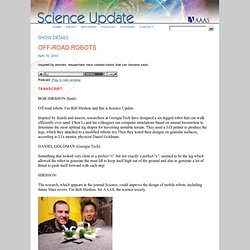
Podcast: Play in new window Transcript BOB HIRSHON (host): Off-road robots. Inspired by lizards and insects, researchers at Georgia Tech have designed a six-legged robot that can walk efficiently over sand. Science Update: The Science Radio News Feature of the AAAS. April 9, 2013 Mysterious “fairy circles” on African plains are caused by termites, which destroy patches of grass but help the surrounding grass thrive.

Podcast: Play in new window Transcript BOB HIRSHON (host): Fairy circles’ cause and effect. Science Update: The Science Radio News Feature of the AAAS. April 8, 2013 Using frozen DNA, researchers have created early-stage embryos of an extinct frog.
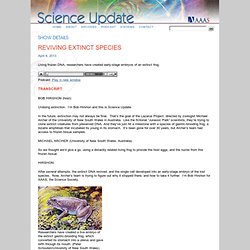
Podcast: Play in new window Transcript BOB HIRSHON (host): Undoing extinction. Science Update: The Science Radio News Feature of the AAAS. April 5, 2013 A new study suggests that mindfulness training can help people stay focused on tasks.

Podcast: Play in new window Transcript BOB HIRSHON (host): This Amazing, Zoomable Universe-In-A-Browser Puts Everything In Perspective. From nanoparticles to galaxies, we can understand a lot about how our universe works--but it's hard to keep things in context. Can you really grasp how far you'd have to travel to reach Mars? Or wrap your head around the infinitesimally small size of a virus? A couple of awesome animations will help. The first one, from London-based designers David Paliwoda and Jesse Williams, is an effective way to see just how far away Mars really is. It's shrunk down to a 100-pixel scale. When you've got Mars down, look at this incredible Flash tool created by Cary and Michael Hwang. You can scroll with a mouse or touchscreen, but I recommend using the slider at the bottom, because then you won't miss any of the lovely animated gifs--from wriggling worms to pulsating Cepheid stars.
Science Update: The Science Radio News Feature of the AAAS. April 4, 2013 New robots are learning how to handle objects by watching humans. Podcast: Play in new window Transcript. Science Update: The Science Radio News Feature of the AAAS. April 3, 2013 Researchers have developed an implantable blood testing sensor that can monitor blood glucose levels and chemotherapy drugs, among other things. Podcast: Play in new window Transcript BOB HIRSHON (host): Remote blood testing. Scientists have invented a tiny, implantable device that analyzes the concentration of chemicals in the blood.
SANDRO CARRARA (Swiss Federal Institute of Technology in Lausanne): Science Update: The Science Radio News Feature of the AAAS. April 2, 2013 Deficiency in a key protein may strongly contribute to cognitive impairments in Down Syndrome. Podcast: Play in new window Transcript BOB HIRSHON (host): A major culprit in Down Sydrome. The lack of a single protein may drive the mental impairments seen in Down Syndrome. Science Update: The Science Radio News Feature of the AAAS. April 1, 2013 Mummies from a variety of different cultures show signs of heart disease.
Podcast: Play in new window Transcript BOB HIRSHON (host): Ancient heart disease. Science Update: The Science Radio News Feature of the AAAS. March 29, 2013 Fighting disease involves maintaining the healthy populations of microbes that live inside us. Science Update: The Science Radio News Feature of the AAAS. March 28, 2013 Fragile X Syndrome, a leading genetic cause of intellectual impairments, may actually result from too much brain activity.
Podcast: Play in new window. Science Update: The Science Radio News Feature of the AAAS. March 27, 2013 Low humidity may increase the transmissibility of the influenza virus indoors. Graphene supercapacitors: Small, cheap, energy-dense replacements for batteries. Science Update: The Science Radio News Feature of the AAAS. March 26, 2013 Just one week of sleep deprivation alters the expression of at least 711 different genes. Science Update: The Science Radio News Feature of the AAAS. March 25, 2013 Low-voltage electricity may help guide bees to the right flowers. Lockheed Martin Desalination Graphene Filters. Science Update: The Science Radio News Feature of the AAAS. March 22, 2013 Cliff swallows are evolving rapidly in response to an urban environment.
Podcast: Play in new window Transcript. Science Update: The Science Radio News Feature of the AAAS. March 21, 2013 Cells that eat up defective brain cells may also target healthy cells during development. Podcast: Play in new window Transcript. Voyager Solar System 'exit' debated. 20 March 2013Last updated at 13:57 ET By Jonathan Amos Science correspondent, BBC News An artist's impression of Voyager 1 as it passes across the Milky Way The possibility that the Voyager-1 spacecraft may have left the Solar System is being hotly debated.
Launched in September 1977, the probe was sent initially to study the outer planets, but then just kept on going. Science Update: The Science Radio News Feature of the AAAS. March 20, 2013 A new anti-fog coating for windshields and eyeglasses also staves off frost. Podcast: Play in new window. Science Update: The Science Radio News Feature of the AAAS. March 19, 2013 Camels seem perfectly suited to life in the desert, but they may have evolved those traits in the high Arctic. Science Update: The Science Radio News Feature of the AAAS. Science Update: The Science Radio News Feature of the AAAS. Science Update: The Science Radio News Feature of the AAAS. Science Update: The Science Radio News Feature of the AAAS. Science Update: The Science Radio News Feature of the AAAS. Science Update: The Science Radio News Feature of the AAAS. Science Update: The Science Radio News Feature of the AAAS. Science Update: The Science Radio News Feature of the AAAS.
Science Update: The Science Radio News Feature of the AAAS. Science Update: The Science Radio News Feature of the AAAS. Science Update: The Science Radio News Feature of the AAAS. Red Cross news and views from Oregon and beyond: Understanding Earthquakes and Volcanoes... with snack foods! (Part 1) Science Update: The Science Radio News Feature of the AAAS. Science Update: The Science Radio News Feature of the AAAS. Now you can read all that scientific research you pay for. Science Update: The Science Radio News Feature of the AAAS. Science Update: The Science Radio News Feature of the AAAS. Science Update: The Science Radio News Feature of the AAAS. Science Update: The Science Radio News Feature of the AAAS. Science Update: The Science Radio News Feature of the AAAS.
Science Update: The Science Radio News Feature of the AAAS. Science Update: The Science Radio News Feature of the AAAS. Science Update: The Science Radio News Feature of the AAAS. Science Update: The Science Radio News Feature of the AAAS. Science Update: The Science Radio News Feature of the AAAS. Science Update: The Science Radio News Feature of the AAAS. Science Update: The Science Radio News Feature of the AAAS. Science Update: The Science Radio News Feature of the AAAS. Science Update: The Science Radio News Feature of the AAAS. Astronauts on ISS to shoot the breeze in Google+ Hangout, answer your questions. Science Update: The Science Radio News Feature of the AAAS.
Science Update: The Science Radio News Feature of the AAAS. Science Update: The Science Radio News Feature of the AAAS. Science Update: The Science Radio News Feature of the AAAS. Science Update: The Science Radio News Feature of the AAAS. Science Update: The Science Radio News Feature of the AAAS. Science Update: The Science Radio News Feature of the AAAS. Science Update: The Science Radio News Feature of the AAAS. Science Update: The Science Radio News Feature of the AAAS. Science Update: The Science Radio News Feature of the AAAS. Teaching Science Is Bolstered by Fewer Lectures and More Working in Groups.
Bill Nye warns: Creation views threaten US science. World's oldest color film footage discovered in museum archive (video) Build a Body. Learningscience.org. BioBuilder - Home. AP Physics. Virtual eye Dissection: The Anatomy of an Eye. 125 Great Science Videos: From Astronomy to Physics & Psychology. Open Culture. Science Assessment ~ Topics. PhET: Free online physics, chemistry, biology, earth science and math simulations.